1996 CHEVROLET CAVALIER fuel
[x] Cancel search: fuelPage 191 of 372
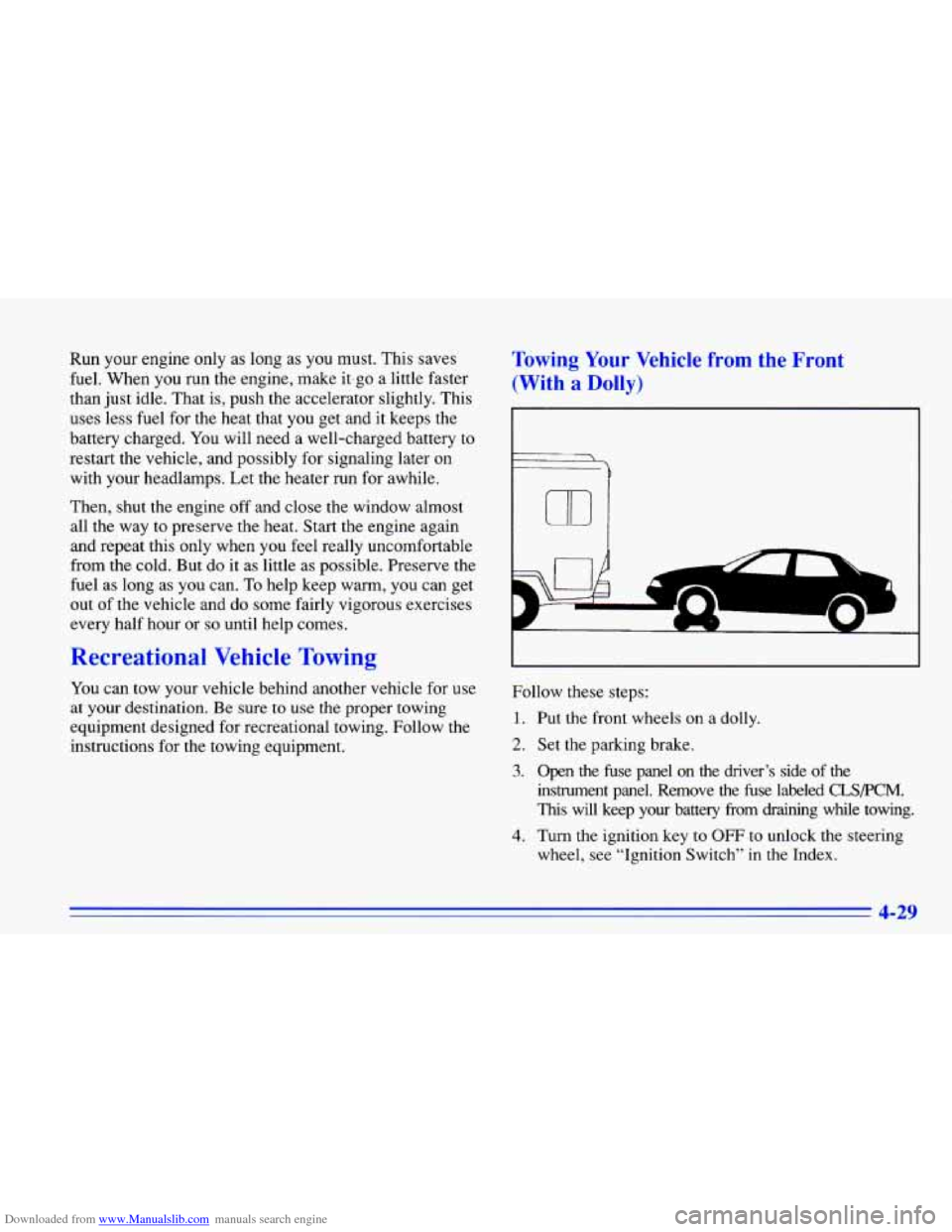
Downloaded from www.Manualslib.com manuals search engine Run your engine only as long as you must. This saves
fuel. When you run the engine, make it.go a little faster
than just idle. That is, push the accelerator slightly. This
uses less fuel for the heat that you get and it keeps the
battery charged.
You will need a well-charged battery to
restart the vehicle, and possibly for signaling later
on
with your headlamps. Let the heater run for awhile.
Then, shut the engine off and close the window almost
all the way
to preserve the heat. Start the engine again
and repeat this only when you feel really uncomfortable
from the cold. But do it as little as possible. Preserve the
fuel as long as you can.
To help keep warm, you can get
out of the vehicle and do some fairly vigorous exercises
every half hour or
so until help comes.
Recreational Vehicle Towing
You can tow your vehicle behind another vehicle for use
at your destination. Be sure
to use the proper towing
equipment designed for recreational towing. Follow the
instructions for the towing equipment.
Towing Your Vehicle from the Front
(With a Dolly)
€
7
m
Follow these steps:
1. Put the front wheels on a dolly.
2. Set the parking brake.
3. Open the fuse panel on the driver’s side of the
instrument panel. Remove the fuse labeled
CLSPCM.
This will keep your battery from draining while towing.
4. Turn the ignition key to OFF to unlock the steering
wheel, see “Ignition Switch’’ in the Index.
4-29
Page 194 of 372
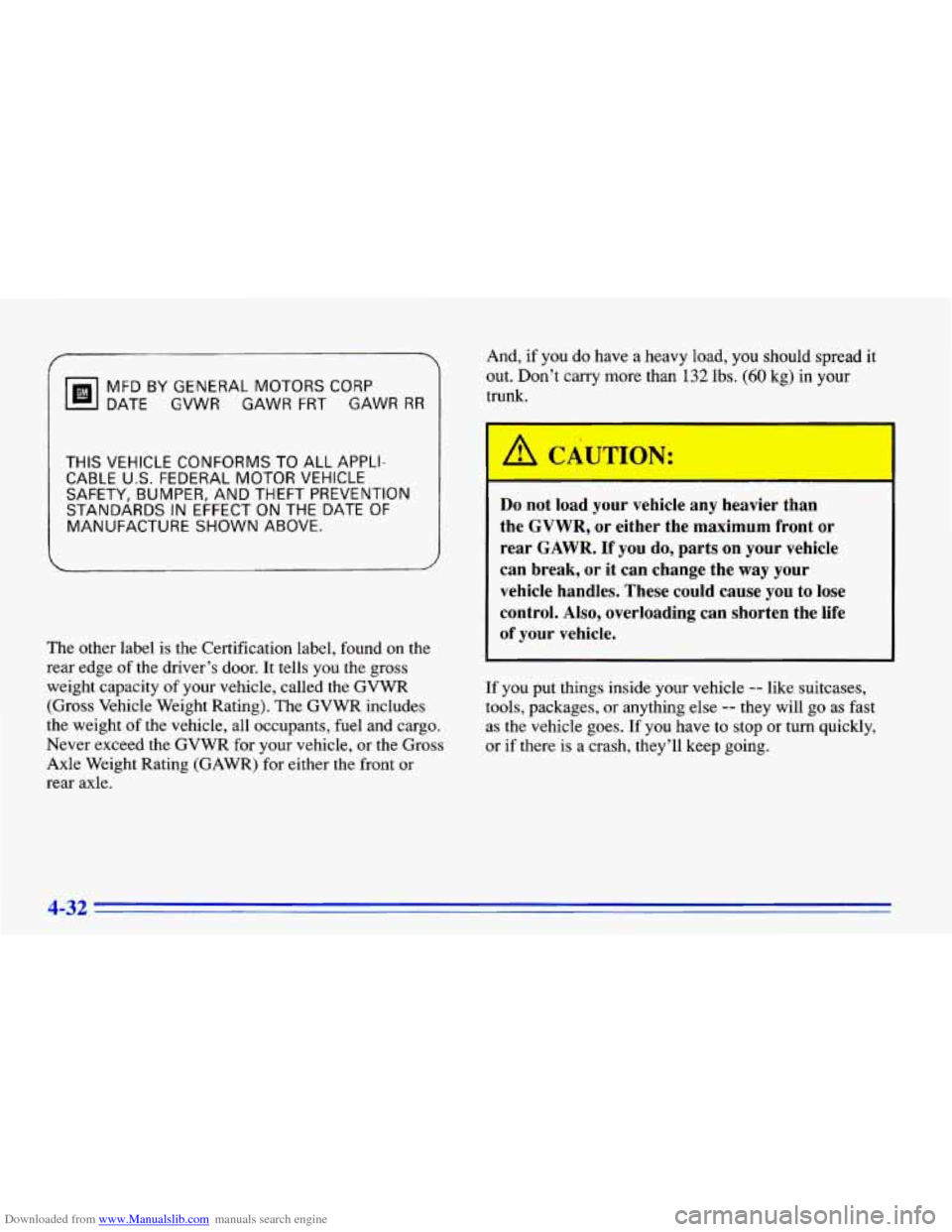
Downloaded from www.Manualslib.com manuals search engine MFD BY GENERAL MOTORS CORP
DATE GVWR GAWR FRT GAWR
RR
THIS VEHICLE CONFORMS TO ALL APPLI-
CABLE U.S. FEDERAL MOTOR VEHICLE
SAFETY, BUMPER,
AND THEFT PREVENTION
STANDARDS IN EFFECT
ON THE DATE OF
MANUFACTURE
SHOWN ABOVE.
The other label is the Certification label, found on the
rear edge
of the driver’s door. It tells you the gross
weight capacity of your vehicle, called
the GVWR
(Gross Vehicle Weight Rating). The
GVWR includes
the weight
of the vehicle, all occupants, fuel and cargo.
Never exceed
the GVWR for your vehicle, or the Gross
Axle Weight Rating (GAWR) for either the front or
rear axle. And,
if you do have
a heavy load, you should spread it
out. Don’t carry more than 132 lbs. (60 kg) in your
trunk.
Do not load your vehicle any heavier than
the
GVWR, or either the maximum front or
rear
GAWR. If you do, parts on your vehicle
can break, or
it can change the way your
vehicle handles. These could cause you to lose
control.
Also, overloading can shorten the life
of your vehicle.
If you put things inside your vehicle -- like suitcases,
tools, packages,
or anything else -- they will go as fast
as the vehicle goes.
If you have to stop or turn quickly,
or if there is a crash, they’ll keep going.
Page 196 of 372
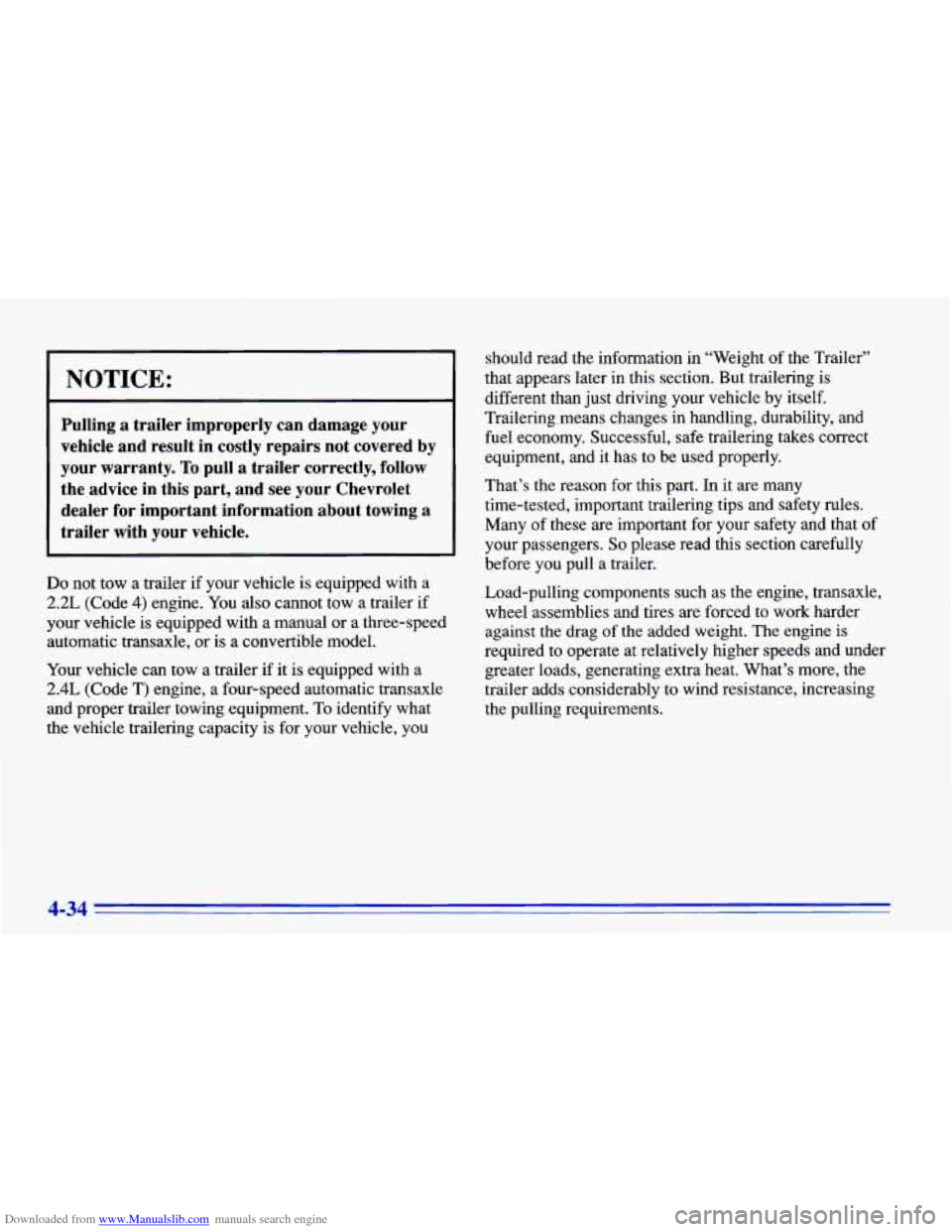
Downloaded from www.Manualslib.com manuals search engine NOTICE:
Pulling a trailer improperly can damage your
vehicle and result in costly repairs not covered by
your warranty.
To pull a trailer correctly, follow
the advice in this part, and see your Chevrolet
dealer for important information about towing a
trailer with your vehicle.
Do not tow a trailer if your vehicle is equipped with a
2.2L (Code
4) engine. You also cannot tow a trailer if
your vehicle is equipped with
a manual or a three-speed
automatic transaxle, or is a convertible model.
Your vehicle can tow
a trailer if it is equipped with a
2.4L (Code
T) engine, a four-speed automatic transaxle
and proper trailer towing equipment.
To identify what
the vehicle trailering capacity
is for your vehicle, you should read the informarlon in “Weight of the Trailer’’\
that appears later in this section. But trailering is
different than just driving your vehicle by itself.
Trailering .means changes
in handling, durability, and
fuel economy. Successful, safe trailering takes correct
equipment, and it has to be used properly.
That’s the reason for this part. In
it are many
time-tested, important trailering tips and safety rules.
Many of these
are important for your safety and that of
your passengers.
So please read this section carefully
before you pull a trailer.
Load-pulling components such as the engine, transaxle,
wheel assemblies and tires are forced to work harder
against the drag
of the added weight. The engine is
required to operate at relatively higher speeds and under
greater loads, generating extra heat. What’s more, the
trailer adds considerably to wind resistance, increasing
the pulling requirements.
4-34
Page 239 of 372
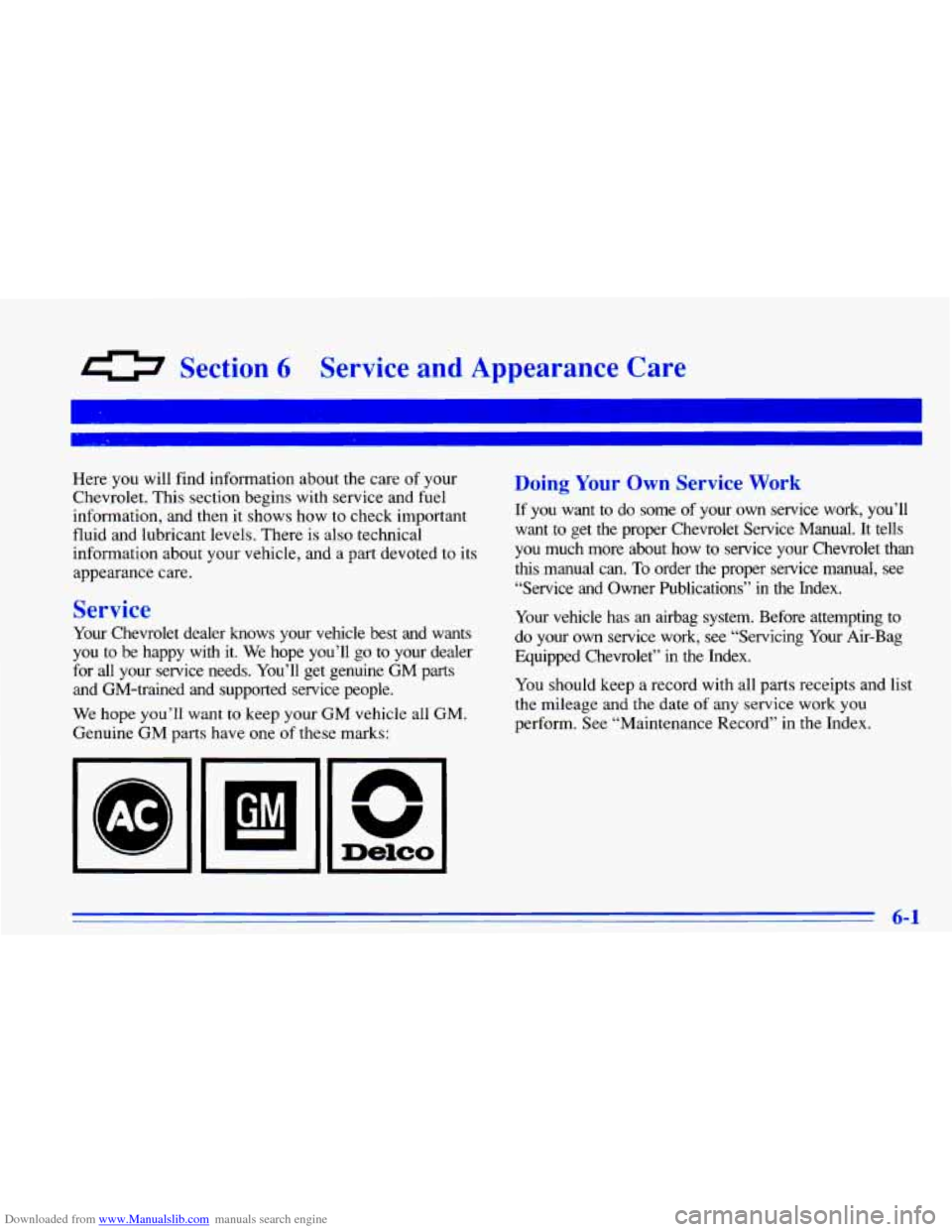
Downloaded from www.Manualslib.com manuals search engine 0 Section 6 Service and Appearance Care
Here you will find information about the care of your
Chevrolet. This section begins with service and fuel
information, and then it shows how
to check important
fluid and lubricant levels. There is also technical
information about your vehicle, and a part devoted to its
appearance care.
Service
Your Chevrolet dealer knows your vehicle best and wants
you to be happy with it. We hope you’ll go to your dealer
for all your service needs. You’ll get genuine GM parts
and GM-trained and supported service people.
We hope
you’ll want to keep your GM vehicle all GM.
Genuine GM parts have one
of these marks:
Doing Your Own Service Work
If you want to do some of your own service work, you’ll
want .to get the proper Chevrolet Service Manual. It tells
you much more about how
to service your Chevrolet than
this manual can.
To order the proper service manual, see
“Service and Owner Publications”
in the Index.
Your vehicle has an airbag system. Before attempting to
do your
own service work, see “Servicing Your Air-Bag
Equipped Chevrolet”
in the Index.
You should keep a record with all parts receipts and list
the mileage and the date
of any service work you
perform. See “Maintenance Record” in the Index.
V
Delco
6-1
Page 240 of 372

Downloaded from www.Manualslib.com manuals search engine You can be injured and your vehicle could be
damaged if you try to do service work on a
vehicle without knowing enough about it.
0 Be sure you have sufficient knowledge,
experience, and the proper replacement
parts and tools before you attempt any
vehicle maintenance task.
0 Be sure to use the proper nuts, bolts and
other fasteners. “English” and “metric”
fasteners can be easily confused.
If you use
the wrong fasteners, parts can later break or fall off.
You could be hurt.
Fuel
Use regular unleaded gasoline rated at 87 octane or higher.
At a
minimum, it should meet specifications ASTM D4814
in the United States and CGSB 3.5-M93 in Canada.
Improved gasoline specifications have been developed by
the American Automobile Manufacturers Association
(AAMA) for better vehicle performance and engine ,
protection. Gasolines meeting the AAMA specification could provide improved driveability and emission control
system protection compared to other gasolines.
Be sure the posted octane is at least 87.
If the octane is
less than 87, you may get
a heavy knocking noise when
you drive.
If it’s bad enough, it can damage your engine.
If you’re using fuel rated at
87 octane or higher and you
still hear heavy knocking, your engine needs service.
But don’t worry
if you hear a little pinging noise when
you’re accelerating or driving up a hill. That’s normal,
and you don’t have to buy a higher octane fuel to get rid
of pinging. It’s the heavy, constant knock that means
you have a problem.
If your vehicle is certified to meet California Emission
Standards (indicated on the underhood tune-up label), it
is designed to operate on fuels that meet California
specifications. If such fuels
are not available in states
adopting California emissions standards, your vehicle
will operate satisfactorily on fuels meeting federal
specifications, but ‘emission control system performance
may be affected. The malfunction indicator lamp on
your instrument panel may
turn on and/or your vehicle
may fail a smog-check test.
If this occurs, return to your
authorized Chevrolet dealer for diagnosis to determine
the cause of failure.
In the event it is determined that the;
cause of the condition is the type of fuels used, repairs
may not be covered by your warranty.
6-2
Page 241 of 372
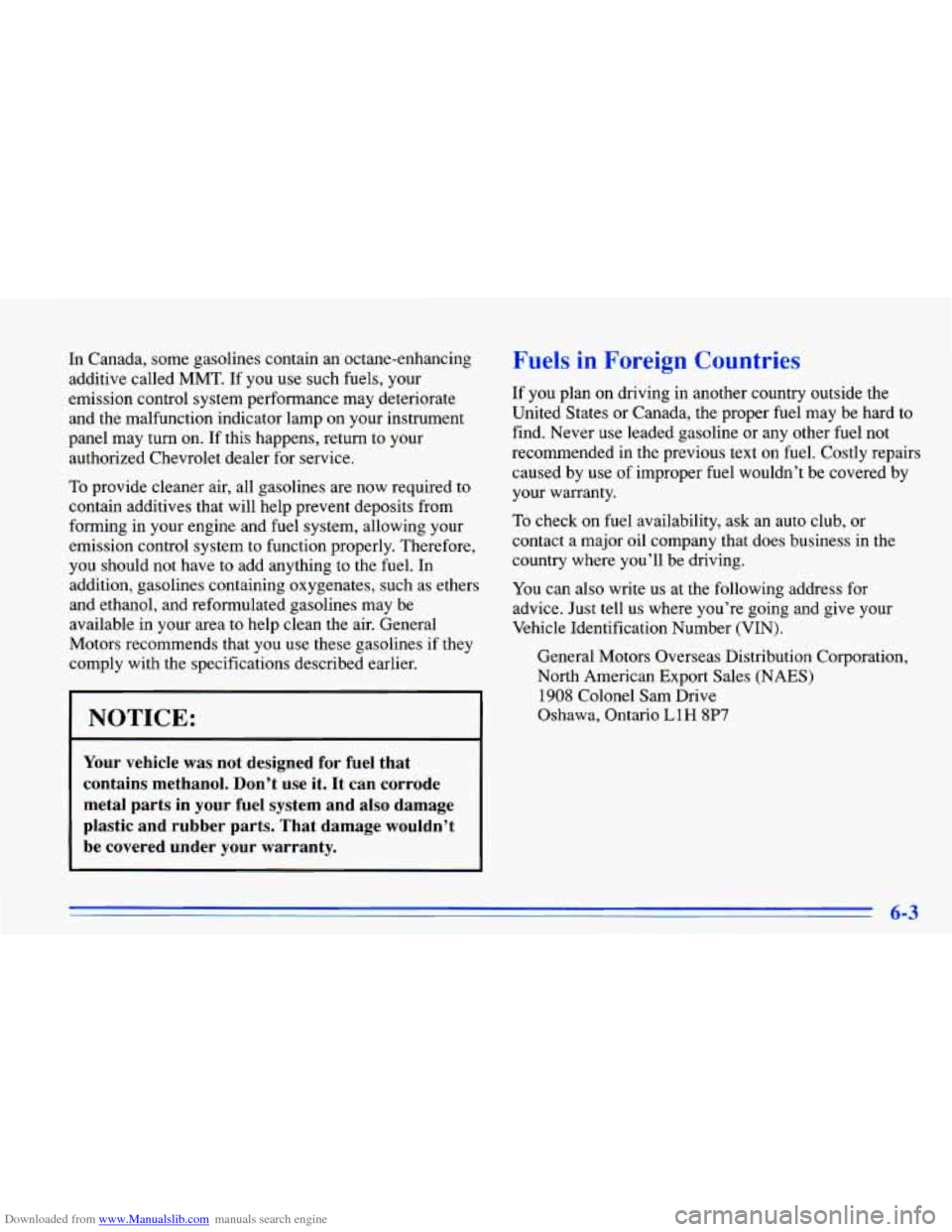
Downloaded from www.Manualslib.com manuals search engine In Canada, some gasolines contain an octane-enhancing
additive called
MMT. If you use such fuels, your
emission control system performance may deteriorate
and the malfunction indicator lamp on your instrument
panel may turn on.
If this happens, return to your
authorized Chevrolet dealer for service.
To provide cleaner air, all gasolines are now required to
contain additives that will help prevent deposits from
forming in your engine and fuel system, allowing your
emission control system to function properly. Therefore,
you should not have to add anything to the fuel. In
addition, gasolines containing oxygenates, such as ethers
and ethanol, and reformulated gasolines may be
available in your area to help clean the air. General
Motors recommends that you use these gasolines if they
c~ lply with the specifications described earlier.
7- I
I NOTICE:
Your vehicle was not designed for fuel that
contains methanol. Don’t use it. It can corrode
metal parts in your fuel system and
also damage
plastic and rubber parts. That damage wouldn’t
be covered under your warranty.
Fuels in Foreign Countries
If you plan on driving in another country outside the
United States or Canada, the proper fuel may be hard to
find. Never use leaded gasoline or any other fuel not
recommended in the previous text on fuel. Costly repairs
caused by use of improper fuel wouldn’t be covered by
your warranty.
To check on fuel availability, ask an auto club, or
contact a major oil company that does business in the
country where you’ll be driving.
You can also write us at the following address for
advice. Just tell us where you’re going and give your
Vehicle Identification Number (VIN).
General Motors Overseas Distribution Corporation,
North American Export Sales (NAES)
1908 Colonel Sam Drive
Oshawa, Ontario
LlH 8P7
6-3
Page 242 of 372

Downloaded from www.Manualslib.com manuals search engine Filling Your Tank
Gasoline vapor is highly flammable. It burns
violently, and that can cause very bad injuries. Don't smoke if you're near gasoline or refueling
your vehicle. Keep sparks, flames, and smoking
materials away from gasoline.
The cap is behind a hinged door on the right side of
your vehicle.
While refueling, hang the tethered cap inside the
fuel door.
To take off the cap, turn it slowly to the left
(counterclockwise).
6-4
-
Page 243 of 372

Downloaded from www.Manualslib.com manuals search engine A :AUTION:
-
If you get gasoline on yourself and then
something ignites it, you could be badly burned.
Gasoline can spray out
on you if you open the
fuel filler cap too quickly. This spray can happen
if your tank
is nearly full, and is more likely in
hot weather. Open the fuel filler cap slowly and
wait for any “hiss” noise to stop. Then unscrew
the cap all the way.
Be careful not to spill gasoline. Clean gasoline from
painted surfaces as soon as possible. See “Cleaning the
Outside of Your Chevrolet” in the Index. When
you put
the cap back on, turn it to the right until
you hear at least three clicks. Make sure you fully install
the cap. The diagnostic system can determine if the fuel
cap has been left off or improperly installed. This would
allow fuel to evaporate into the atmosphere. See
“Malfunction Indicator Lamp” in the Index.
NOTICE:
If you need a new cap, be sure to get the right
type. Your dealer can get one for you. If you get
the wrong type, it may not
fit or have proper
venting, and your fuel tank and emissions system
might be damaged.
6-5